Warning
Some legal 'information' from social media or even friends can be unreliable or incorrect. Please ensure you are getting legal information and advice from a Victorian Community Legal Centre, a registered Victorian law firm, or a from a lawyer with experience in Victorian law, and with knowledge of Victorian protest-related charges and offences.
Resources
Legal Rights Information
Below is a list of resources that cover different aspects of your civil and political rights.

activistrights.org.au
The Activist Rights website is for people who are trying to create positive changes in their lives and communities. Resources on the site have been drawn from around the world and from experience in Australia to help support new and experienced activists, campaign organisers, legal workers and progressive lawyers.
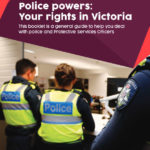
Police Powers: Your Rights in Victoria
This booklet, published by Victorian Legal Aid, is a general guide to help you when you deal with the police and Protective Service Officers.
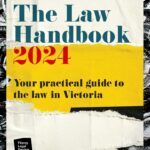
The Law Handbook — Your practical guide to the law in Victoria
The Law Handbook is a practical guide to the law in Victoria authored by over 80 legal experts. It provides free comprehensive information about the laws that affect Victorians in everyday life. The guide is published by Fitzroy Legal Service.
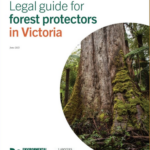
Legal Guide for Forest Protectors
The Legal Guide for Forest Protectors guide, prepared by Environmental Justice Australia (EJA) and Lawyers for Forests Inc. (LFF), responds to some of the most common legal questions and issues that arise in forest actions. The guide incorporates the amendments to forest protest laws in the Sustainable Forests Timber Act 2004 (Vic) in effect from 20 May 2023.
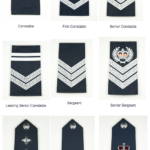
Who's Who in Victoria Police?
This is MALS own guide to the Who's Who in Victoria Police. The identification of individual officers goes to the heart of accountability. It is useful for Legal Observers, journalists, street medics and activists to have an idea who is who. With accurate identification we can get a sense of how different police units might act and more accurately identify police in the case of an incident or for an eventual complaint or legal action.
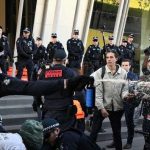
What to do if you are assaulted or OC sprayed by police in Victoria
What to do if you are affected by OC spray or assaulted by police at a protest in Victoria.
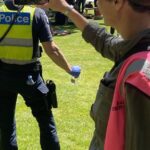
Your rights in Designated Areas
This is a legal rights guide on the three main police powers affecting people at protests inside a ‘designated area’: 1) searches 2) directions to remove face coverings and 3) directions to leave the area.
Sometimes, Victoria Police will declare a designated area in the lead-up to a protest event.
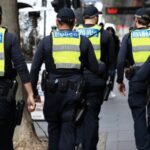
Police home visits & property searches
What should I do if police come to my house? MALS is concerned about police operations that use legal processes to target, intimidate and harass activists. This short guide helps activists respond when police come knocking.
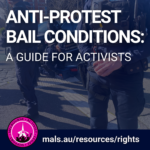
Anti-Protest Bail Conditions: A guide for activists
Anti-protest bail conditions have been used by police to disrupt activist groups and undermine the ability of social movements to organise. It is vital that all protest groups make plans in case police decide to apply anti-protest bail conditions against your group or campaign and understand how you can challenge them.

Declaration of our Right to Protest
The Declaration of our Right to Protest asserts the fundamental right to protest and outlines the standards that all government agencies must uphold. The Declaration is grounded in human rights law and was produced by the Human Rights Law Centre, with support from the Australian Democracy Network and in collaboration with grassroots activists and experts across the continent. The Declaration has been endorsed by over 60 civil society organisations including the Australian Council of Social Services, Greenpeace Australia, and Amnesty International Australia.
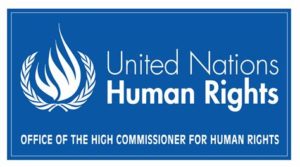
International Human Rights Standards for Law Enforcement
The United Nations Centre for Human Rights has been engaged for years in the training of national law enforcement officials. This document is the third global contribution of the Centre's police training programme, and is designed to provide a "readily accessible and portable reference for police committed to the lawful and humane performance of their vital functions in a democratic society."
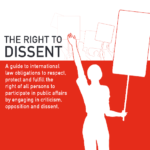
The Right to Dissent
This useful guide by Lawyers Rights Watch Canada explains the international legal standards and underlying principles and interpretations of the standards that comprise the international legal framework for the right to dissent and protest.
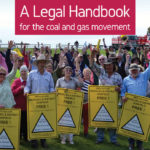
Legal Handbook for the Coal and Gas Movement
This resource allows people to take informed risks and be educated on their legal rights while taking on the coal and gas industries. Written and published by CounterAct and Environmental Justice Australia.
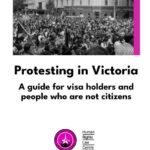
Protesting in Victoria: A guide for visa holders and people who are not citizens
Everyone in Victoria has the right to protest, regardless of citizenship or visa status. However, considering the ever-changing political climate, visa holders or people who are not citizens may face additional risks when participating in demonstrations and protests. This guide provides an overview of those risks.
Helpful?
If you like these resources, please make a small donation to keep us going.
Something to Add?
If you have an informational resource that you’d like to see added to this list, please contact us.